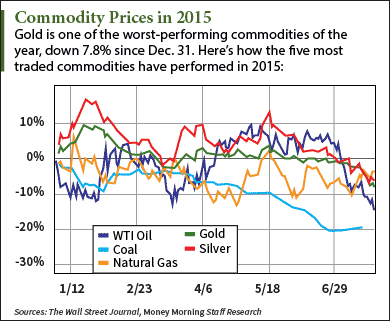Any talk of commodity prices in 2015 has typically revolved around oil prices. That's because we're experiencing the worst oil price crash since the 2008 financial crisis.
WTI oil prices are down 48.5% in the last year. The U.S. benchmark closed at $48.85 a barrel Wednesday, its lowest settlement in more than four months.
But what most investors don't know is that oil is nowhere near the biggest loser among the most common commodities.
Here's how commodity prices have performed so far this year...
How Have Commodity Prices Performed in 2015?
 It's been a rough year so far for commodities, since most of them are priced in U.S. dollars. When the dollar strengthens, commodity prices weaken because the underlying products become more expensive to users of other currencies.
It's been a rough year so far for commodities, since most of them are priced in U.S. dollars. When the dollar strengthens, commodity prices weaken because the underlying products become more expensive to users of other currencies.
And the dollar has surged in 2015. It's up 7.7% so far this year and 1.7% in July alone.
Precious metals have taken the worst beatings...
Gold prices are down 8.1% in 2015. Futures settled at a five-year low of $1,103.50 an ounce on Tuesday, two days after a "flash crash" sent the yellow metal down 4.2% within seconds. Silver prices have followed a similar pattern, falling 6.8% this year and hitting a new low of $14.63 on Monday.
The two other main energy commodities, coal and natural gas, have also plummeted in 2015.
Futures for Central Appalachian coal - the benchmark for the New York Mercantile Exchange (NYMEX) - have tumbled 18.8% in 2015 as more power companies switch to natural gas. The U.S. Energy Information Administration (EIA) expects coal usage to decrease by 7% this year.
Despite seeing increased demand from declining coal usage, natural gas prices are still down 6.6% this year due to oversupply and mild weather.
With commodity prices down across the board, the question on investors' minds is...
Will Commodity Prices Rebound in the Second Half of 2015?
According to Money Morning Resource Specialist Peter Krauth, both gold and silver could head lower before finally hitting a bottom. But after recovering from any interest rate hike within the next six to 12 months, their prices will skyrocket alongside demand.
[epom key="ddec3ef33420ef7c9964a4695c349764" redirect="" sourceid="" imported="false"]
"Silver's industrial demand remains strong," Krauth explained. "Gold could well be headed lower before it finally bottoms, but gold's bull market is far from over."
Meanwhile, oil and natural gas will start to rebound by the end of the year.
Money Morning Global Energy Strategist Dr. Kent Moors says oil supply will start shrinking significantly as more wells go offline. Most U.S. shale wells were drilled about 18 months ago, which is about how long it takes for their production to peak. That means output will significantly decline between now and September.
Natural gas prices will rise thanks mostly to the permanent demise of coal demand. By 2020, about one-third of the United States' coal-generating capacity from 2012 will have been retired and replaced with natural gas. That's because the federal government is dedicated to limiting carbon emissions that contribute to climate change and health problems.
"To put this in perspective, this transition alone - ignoring any of the impact on coal from the intensifying Environmental Protection Agency standard increases - will eliminate almost twice the current natural gas storage surplus nationwide," said Moors.
Avoid this gold scam and make sure you own the real deal – this video has seven steps to test your physical gold today:
More on Oil Prices: Oil prices have crashed nearly 50% since last July. But oil volatility is hardly a new concept. Here's a timeline of the history of crude oil prices dating all the way back to the Civil War...


